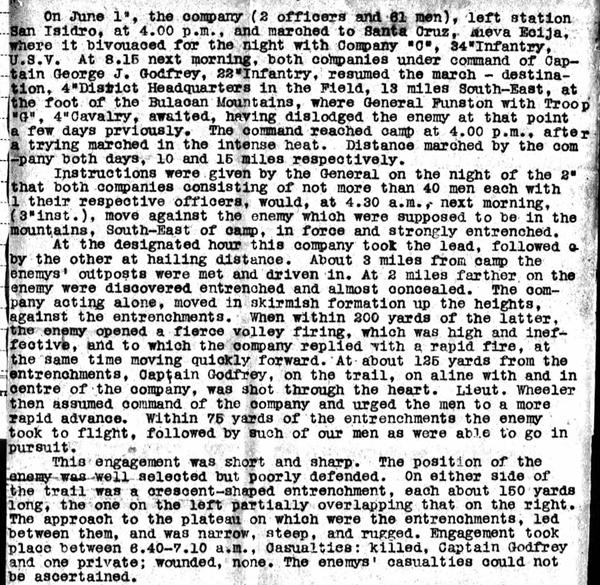
George John Godfrey
Commanding Officer
Company A 22nd Infantry
KIA 06/03/1900
George J. Godfrey entered the US
Military Academy on July 1, 1882, and graduated 56
out of a class of 77, on July 1, 1886. His best subjects were
Drawing and English, and his worst subjects
were Law and Chemistry. He was in the same graduating class as
John J. Pershing.
Upon graduation, he was
commissioned a 2nd Lieutenant in the 12th Infantry. He served in
garrison duty
at Madison Barracks, New York, from September 20, 1886, to July
25, 1887. He served on frontier duty
at Fort Sully, Dakota Territory, from July 25 to August 22, 1887.
From September 1887, to October 19, 1888,
Godfrey was at the Infantry and Cavalry School of Application at
Fort Leavenworth, Kansas.
He then took a sick leave of
absence, and returned to frontier duty at Fort Sully, from April
8, 1889, to
May 10, 1890. From May 10 to October 21, 1890, he was on duty at
old Fort Pierre, South Dakota. He was
then back at Fort Sully until November 12, 1890, when he changed
station to Fort Bennett, South Dakota,
where he remained until May 26, 1891, at which time he returned
to Fort Sully, until March 30, 1893.
Godfrey was promoted to 1st
Lieutenant of the 22nd Infantry on February 1, 1893
and assigned to Company A.
He was at Camp Merritt, Montana,
from August 27 to November 1, 1894, and at Fort Keogh, Montana,
from September 24, 1895 to May 7, 1896. He was then on sick leave
until December 9, 1896, at which
time he returned to the Regiment at Fort Crook, Nebraska, and
served on garrison duty there. He was
with the Regiment at Tampa, Florida from April 18 to June 14,
1898, and landed with the 22nd Infantry
in Cuba on June 22, 1898. He was in the Santiago campaign in
Cuba, and wounded at the Battle of El Caney,
on July 1, 1898. He was on sick leave recovering from his wounds
until October 18, 1898, when he rejoined
the Regiment at Fort Crook. Between January 27 and March, 1899,
he was sick and enroute to
San Francisco, California.
Godfrey was promoted to Captain in the 22nd Infantry on March 2, 1899.
He joined the Regiment in the Philippines on June 3, 1899.
Captain George Godfrey was
killed in action, as Commanding Officer of Company A, 22nd
Infantry, along with
Private Perry G. Ethridge, at approximately 7 a.m., on June 3,
1900, as part of a detachment from the 22nd Infantry,
under the command of General Frederick Funston. Funston's column
had been operating in the Bulacan Mountains,
east and north of the town of San Miguel de Mayumo, on the island
of Luzon, since May 31, 1900, and had fought
with insurgent forces in several engagements.
Captain Godfrey was killed in
one of those engagements, at 7a.m. on June 3, in the mountains
approximately 25 miles
east of San Miguel.

Above: The after action report filed by 1st Lieutenant David P.
Wheeler of Company A.
Wheeler assumed command of Company A upon the death of Captain
George Godfrey
on June 3, 1900 and continued the assault upon the enemy
positions. The "one private"
he mentions as being killed was Private Perry G. Ethridge of
Company A.
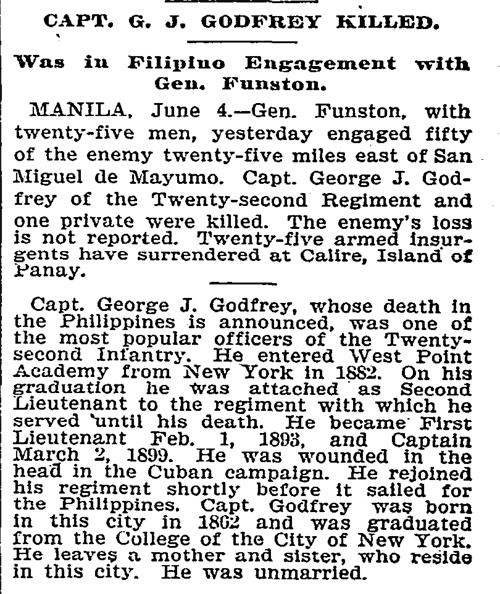
Article announcing the death of George Godfrey, from the New York Times, June 5, 1900
Capt.
George Godfrey Killed
Gen. Funston in a Fight With Rebels Yesterday
Manila,
June 4. General Funston, with twenty-five men, engaged fifty of
the enemy twenty-five miles east
of San Miguel de Mayumo yesterday.
Captain
George J. Godfrey of the 22d Regiment and one private were
killed. The enemy’s loss is not reported.
Twenty-five armed insurgents have surrendered at Cafire, Island
of Panay.
Omaha, Nebraska, June 4. Captain George Godfrey, reported killed
in the Philippines, was stationed at Fort Crook
with the 22d Regiment and was one of the most popular officers in
the regiment. He entered West Point from New York
and graduated in 1884. He was wounded in the head in the Cuban
campaign. He rejoined his regiment shortly before
it sailed for the Philippines.
Captain George J. Godfrey, 22d Infantry, who, according to the
latest news dispatches from eh Philippines, was killed
in an engagement twenty-five miles east of San Miguel de Mayumo,
yesterday, was born February 14, 1862. He was
a native of New York and appointed to the West Point Military
Academy from that state, graduating with the class of 1886.
In February 1893, he was promoted from Second lieutenant of the
12th Infantry to be First Lieutenant of the 22d Infantry.
He served with gallantry through the Spanish War and was
specially mentioned for efficient service before Santiago by
General Ludlow. He was wounded in action at El Caney July 1,
1898. In January 1899, he embarked with his
regiment for Manila and took a prominent part in the Philippine
campaigns. He was recommended for brevet
by major General Lawton for distinguished conduct in the presence
of the enemy. He was promoted to a Captaincy
March 2, 1899 and served with the 22d Regiment up to the time of
his death.
From The Evening Star Monday June 4, 1900
Below is the listing of Captain
George Godfrey's name in a report of deaths from Company A 22nd
Infantry,
from March 1899 to January 1901, as written on January 3, 1901,
by 1st Lieutenant David P. Wheeler,
who was temporarily in command of Company A on that date. Wheeler
would also be killed in action
in the Philippines three years later.
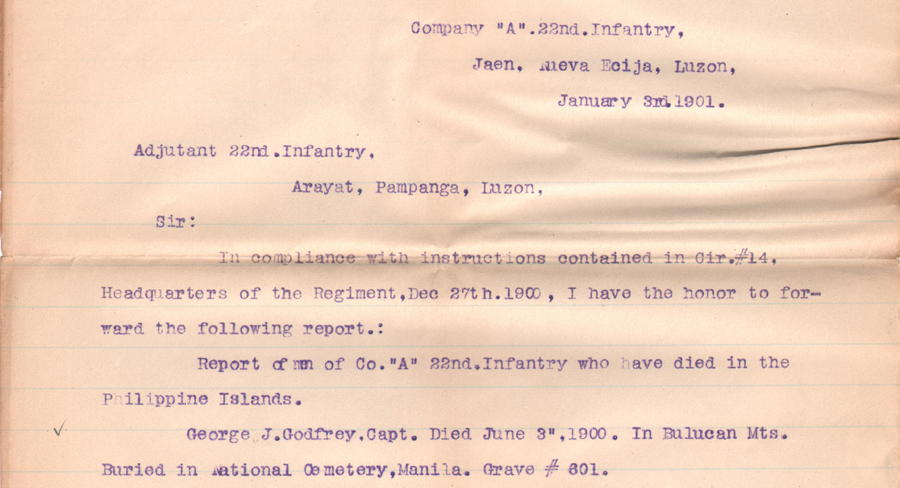

Document courtesy of Matthew Westfall, author of The Devil's Causeway
GEORGE J. GODFREY.
No. 3152. CLASS OF 1886.
Killed, June 3, 1900, at San Miguel de.Mayumo, Luzon, P. I.,
aged 38.
Captain GODFREY was born in New
York, February 14, 1862, and appointed to the Military Academy
from New York.
He entered West Point July 1, 1882, and graduated in 1886. He was
appointed Second Lieutenant, Twelfth Infantry;
promoted to the next grade February 1, 1893, and reached his
Captaincy March 2, 1899.
For the following record of his
services the Association is indebted to the War Department: He
joined his company
September 20, 1886, and served with it at Madison Barracks, N.
Y., to September, 1887; at the U. S. Infantry and
Cavalry School, Fort Leavenworth, Kas., to October 10, 1888; on
sick leave to, April 8, 1889; with regiment at Fort Sully,
South Dakota, to March, 1893; Fort Keogh, Montana, to September,
1895; Fort Yates, North Dakota, to May, 1896;
on sick leave to December, 1896; with regiment at Fort Crook,
Neb., to April, 1898; Tampa, Fla,, to June, 1898;
in the Santiago campaign to July, 1898, being wounded in action
at El Caney, Cuba, July 1, 1898; sick and on sick leave
on account of wounds to October 18, 1898; with regiment at Fort
Crook, Neb., to January, 1899; at San Francisco, Cal.,
sick, to February, 1899; en route to and in the Philippine
Islands to June 3, 1900, when he was killed in action at
San Miguel de Mayurno, Luzon, P. I,
Captain Godfrey was recommended
for brevet for gallantry at El Caney, Cuba, and for arduous and
efficient service
in the campaign in the Philippine Islands.
SECRETARY OF THE ASSOCIATION. ¹
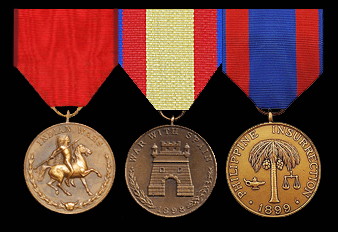
George J. Godfrey's decorations
George John Godfrey
CAPTAIN, 22nd U. S. INFANTRY
KILLED IN ACTION JUNE 3, 1900; AGED 39.
Wounded at El Caney, killed in
action in the Philippine insurrection—this might well
constitute the whole obituary of a soldier.
To have this glorious testimony of duty done graven on a tablet
in the Memorial Hall at West Point was the good fortune
of our dead classmate. As we remember him—the "boy
officer" of Kipling—we might not at first associate his
trim form
and gentle ways with such a record as this; but we who know what
the motto "Duty, Honor, Country" means to all the sons
of West Point, know also that every one of them would be glad to
meet with such a fate as this.
Godfrey came to the Academy from
New York City and was assigned to "C" Company. He went
through the four years,
his career unmarked by any lofty ambition for chevrons or by
frequent perambulations on the area. The writer remembers him
particularly as a faithful attendant at the hops, where he
chiefly distinguished himself by always selecting the tallest
girl in the room
to dance with, and by the cheerful way in which he often helped
out a distracted hop manager with a large bouquet
of wall-flowers on his hands.
On graduation he was assigned as
2nd Lieutenant, 12th Infantry, and joined, after the usual leave,
at Fort Sully, S. D.
He spent the seven years of service in this regiment at the above
named post, at old Fort Pierre, S. D., and at Fort Bennett.
On February 1, 1893, he was promoted 1st Lieutenant, 22nd
Infantry, and joined his new regiment at Fort Keogh, Montana,
in April of the same year. The usual garrison duties were
performed at this post, at Forts Yates and Meade, S. D., and at
Fort Crook, Nebraska, until 1898, with the exception of a tour of
duty in the railroad strikes of 1894 on the Northern
Pacific Railroad and a long sick leave of seven months in 1896.
At the outbreak of the war he
accompanied his regiment to Tampa and sailed with the Santiago
Expedition on June 14, 1898.
He was shot in the attack on El Caney, July 1st, and when the
fighting was over he was invalided home on a three months'
sick leave. At the conclusion of this leave he rejoined his
regiment at Fort Crook, Nebraska, in October, 1898. Although
unfit
for field service as the result of his wound received in the
Santiago campaign, he started with his regiment for the
Philippines
in January, 1899; but on reaching San Francisco he was unable to
continue farther, and was given a three months' sick leave.
He was promoted Captain, 22nd Infantry, March 2, 1899, and sailed
for the Philippines, where he arrived in June of the same year.
He commanded Company
"D" of his regiment at Candaba, P. I., performing at
the same time the duties of Provost Marshal
at that place. In November he was transferred to Company
"A." During this period he was engaged in the trying
service
incident to the insurrection, and stuck to his post, although
often too sick to be on duty roster at all. In January, 1900,
he assumed command of Santa Anna, Pampanga, Luzon, and continued
on this duty to March 15, 1900. On the early morning
of June 3, 1900, he was killed in action at Bulucan Mountain,
near San Miguel de Mayumo, and later was buried in the
National Cemetery at Manila.
The following order was issued upon his death from the headquarters of his regiment:
HEADQUARTERS 22ND U. S.
INFANTRY,
ARAYAT, LUZON, P. I., June 4, 1900.
GENERAL ORDERS, No. 10.
Captain George J. Godfrey, 22nd
U. S. Infantry. Killed in action. Shot through the heart.
His military record is closed. A brilliant career ended.
Deeds, silent symbols more
potent than words, proclaimed his soldier worth.
The histories of the 5th and 8th Army Corps are his.
Official commendation but emphasized what all men knew.
Cuban soil saw his valor.
Under a tropical sun, on morn of June 3, 1900, among the lonely
fastnesses of the Bulucan Mountains,
as victory crowned the combat, he gave for "the flag"
the life he had dedicated to his country.
His mind was trained for the profession of arms.
His heart and impulses were generous.
Conscientious and zealous discharge of duty were his guiding
tenet.
He sought no preferment through avenues foreign to the service.
His first thought was his country's cause—personal ambition
his last.
Thus he stood a peer among the best type of American soldier.
In the civil administration of a pueblo, to the misguided native
people he extended the hand of fellowship and led them
along the true path of civilization. His work is enduring.
Into the unspeakable grief which now moves the hearts of those
who dwell in our far-distant native land, we dare not enter.
In silence and with memory filled with sorrow, the Regiment
stands and mourns with them for our brother.
By order of Major Baldwin:
(Signed) " H. C. HODGES, JR.,
Captain, 22nd Infantry, Adjutant. Official:
GEO. S. SIMONDS,
Captain, 22nd Infantry, Adjutant.
J. E. McM. ²
George J. Godfrey was buried in
the National Cemetery at Manila, Philippines in Grave #601.
His remains were later returned to the United States where he was
interred
in New York.
Burial:
United States Military Academy Post Cemetery
West Point
Orange County
New York
Plot: Section XIII, Row A Site, 7273

The grave of Captain George J. Godfrey in the United States Military Academy Post Cemetery
Photo by Julia G from the Find A Grave website
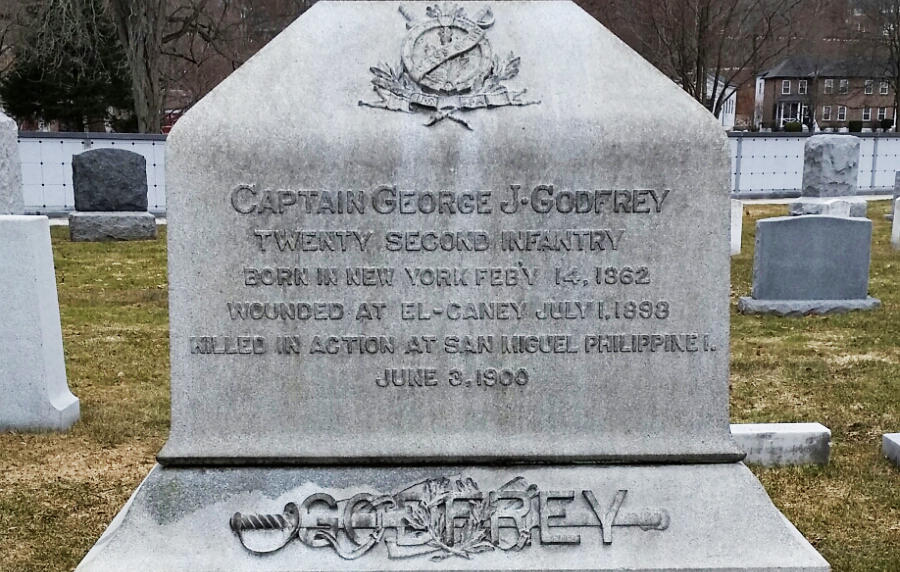
The inscription on the grave marker of George J. Godfrey
Photo by Julia G from the Find A Grave website
**********************
On February 14, 1902, a battery
of three 12 inch guns at Fort Winfield Scott, at the Presidio of
San Francisco,
California, was named Battery Godfrey, in honor of Captain George
Godfrey. The battery was built in 1895,
renamed for Godfrey in 1902, and remained in operation until
1943, when its guns were broken up for scrap.
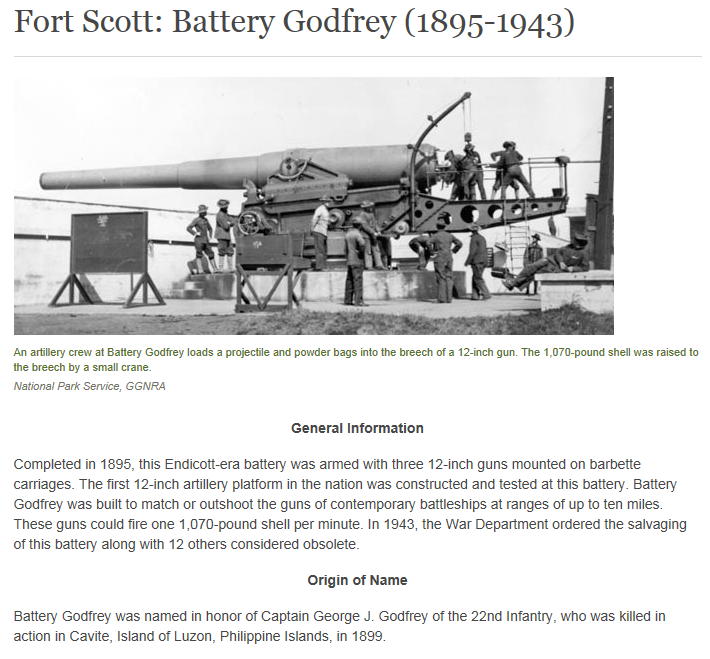
Above photo shows Battery Godfrey in operation, circa 1900-1910.
Graphic from the National Park Service website
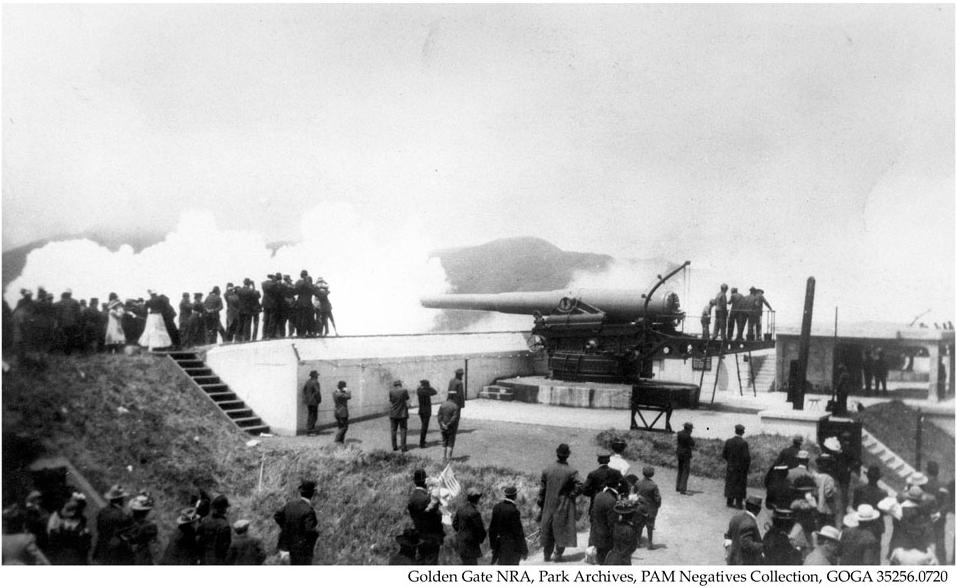
Test firing one of the 12 " guns at Battery Godfrey, circa 1910.
Photo from the National Park Service
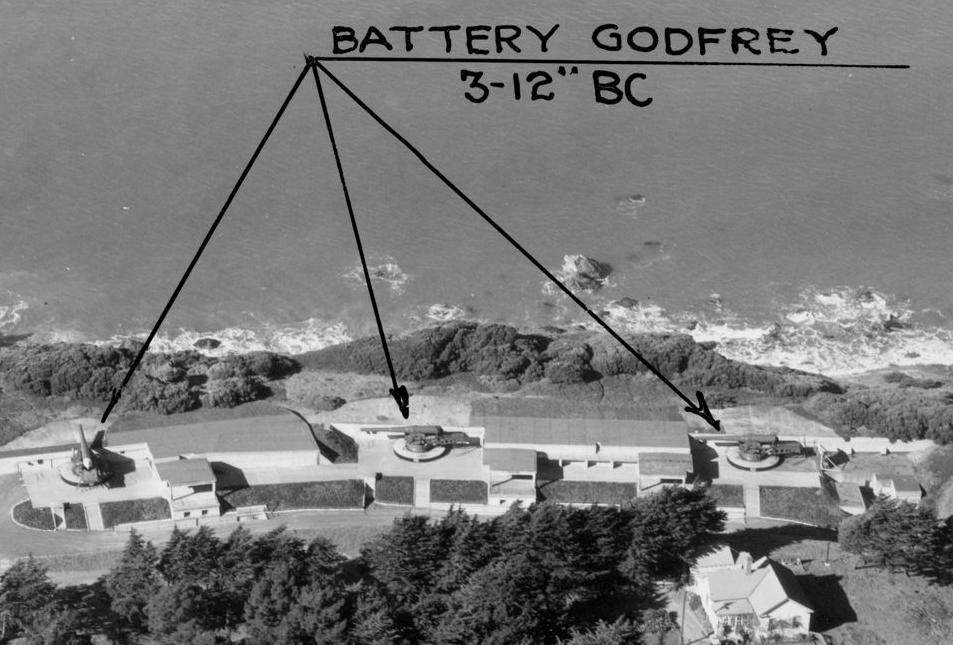
An aerial view of Battery Godfrey, showing all three guns.
Photo from the Fort Wiki website
Though the guns have long been
removed, the concrete emplacements of Battery Godfrey
still stand at the Presidio of San Francisco National Park. As
can be seen from the photo below,
Battery Godfrey is at the end of the Presidio near the Golden
Gate Bridge:
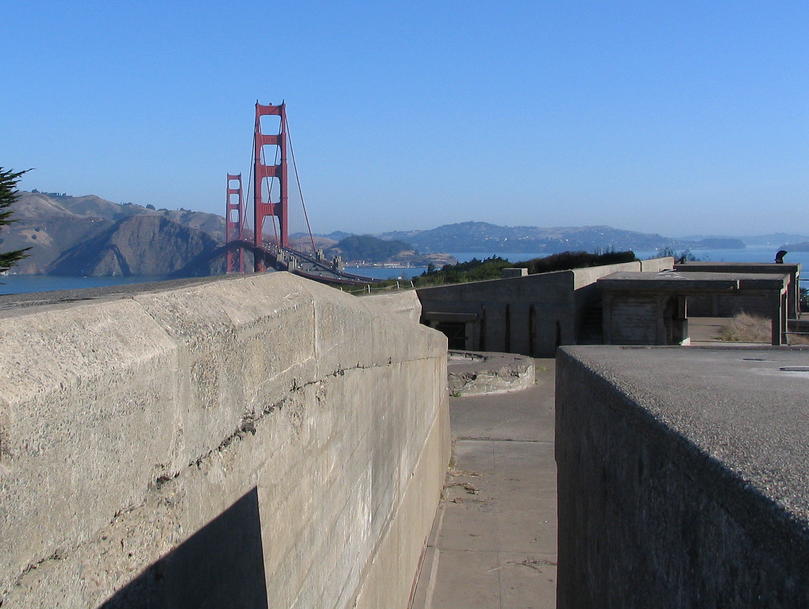
Golden Gate Bridge, as seen from Battery Godfrey
Photo by Peter Kaminski from the Flickr website
For a detailed look at Battery Godfrey, click on the following link:
The California State Military Museum
**********************
¹ THIRTY-FIRST ANNUAL REUNION of The
Association of Graduates of the United States Military Academy,
at West Point, New York, June 12th, 1900, Seemann & Peters,
Printers and Binders, Saginaw, Michigan 1900
² 1886-1911 In Commemoration of the 25th Anniversary of Graduation of the Class of '86, U.S.M.A. West Point, June, 1911
Home | Photos | Battles & History | Current |
Rosters & Reports | Medal of Honor | Killed
in Action |
Personnel Locator | Commanders | Station
List | Campaigns |
Honors | Insignia & Memorabilia | 4-42
Artillery | Taps |
What's New | Editorial | Links |